On November 19, 2008, thousands of residents in and around Philadelphia, the United States' fourth largest urban area by population, watched in awe as dozens of stationary light pillars loomed up in the evening sky.
Those who saw this colourful display spoke of a wonderful experience. One couple from West Chester was brought to tears, while a woman from Boothwyn thought she was "going nuts". Others referred to the lights as "eerie", "pretty", "awesome" and "very cool".
Two witnesses, Mr. Daniel LEVIN from Garnet Valley and Mr. Anthony VELGUS of White Haven, contacted CAELESTIA directly. Their first-hand account can be found elsewhere on this web site.
Below is a cropped version of a photo of the mysterious lights taken by another witness, Mr. David WEI from Plymouth Meeting, also in Pennsylvania and 13.1 miles northwest of Philadelphia's city centre.
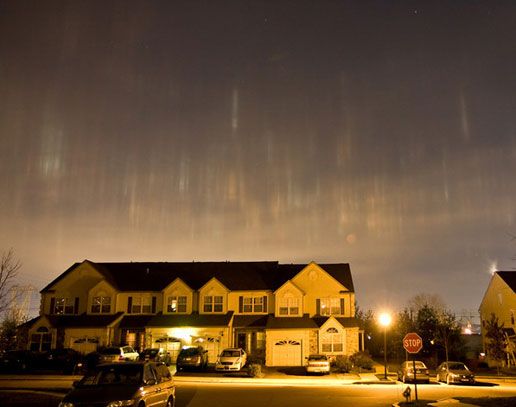
Speculation about the origin of the lights on the Internet, and particularly on NBC's Philadelphia Weather Stories forum, ranged from the plausible ("aurora borealis") to the implausible ("fallout from the Alaskan volcano that erupted in August"), and from the quasi-scientific ("moonlit bands of snow") to the totally unscientific ("alien spy craft" and "covert military experiments").
- www.nbcphiladelphia.com/weather/stories/Planes_Rains_or_UFOs.html
- E-mails received from Mr. LEVIN and Mr. VELGUS on November 20, 2008.
From the moment we set eyes on the photos which Mr. WEI and several other witnesses had made of the phenomenon, it was clear to us that the pillar-shaped lights were the mirrored images of poorly shielded city lights reflecting in a sea of ice-crystals floating over the city. An optical phenomenon known as Artificial Light Pillars.
Below is a second photo taken by David WEI from Plymouth Meeting. According to the photo's EXchangeable Image File data (EXIF), it was taken at 9:36:56 p.m. DST (i.e. 8:36:56 p.m. EST), facing southeast. David used a Canon 40D camera fitted with a 17 mm wide-angle lens. The exposure time is believed to have been 1.3 seconds. The aperture was set at f/2.8 [1].
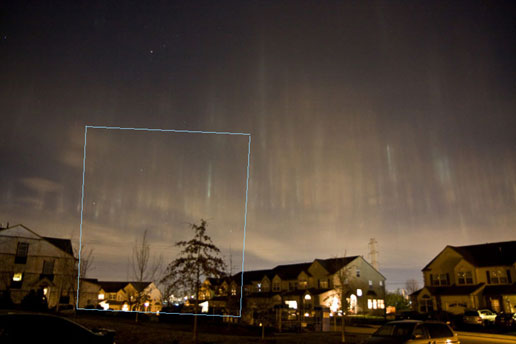
In an attempt to determine the altitude of the ice-crystal layer that produced the light pillars on the photo, we first selected a bright specimen flanked by a group of stars that would be easy to identify with the help of a sky map. Our choice fell on a bright, whitish coloured pillar - actually two pillars close together - visible above a tree in the left half of the photo. To the immediate left of this double pillar and closer to the horizon are three dots in a straight line, evenly spaced from one another: the stars that make up te belt of the Orion constellation.
We marked this area of interest with a blue rectangle. The image below is a blow-up of this section. The double pillar is marked with an arrow. The stars that are part of the Orion constellation are indicated with their respective astronomical symbols.
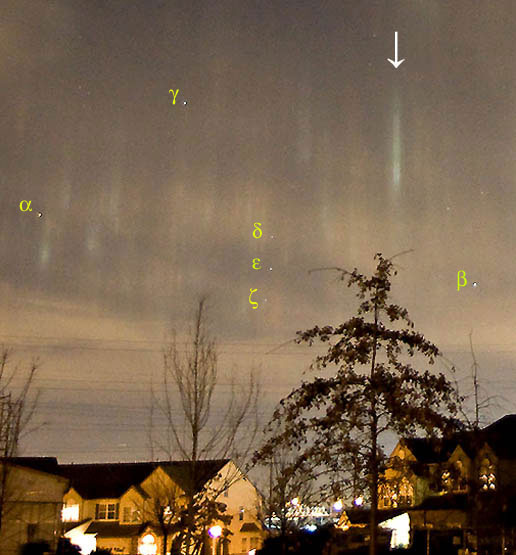
Next we consulted a sky map with the position of the visible stars for the time and place the photo was taken. We used the free StarCalc program (version 5.73) which can be downloaded at www.m31.spb.ru/StarCalc.
Shown below is a portion of the southeastern quadrant of the sky with a focus on the Orion constellation. Added is the double pillar as it appears in the photo. The sky map reveals that its brightest area was located 15° above the horizon and that the azimuth for the pillars was 106° (calculated from N over E).
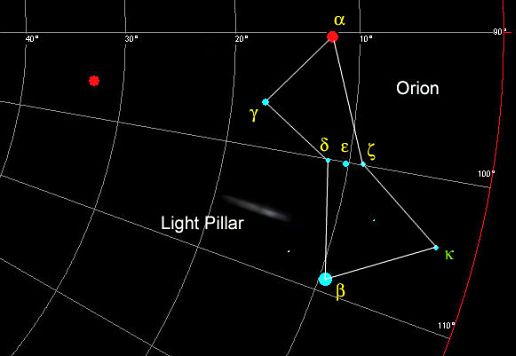
In order to determine the actual height and distance of the reflective ice-crystal layer, we now need to find out where the light sources were that caused them.
Having established the azimuth, we drew a yellow line on a Google Earth satellite image of Plymouth Meeting indicating the direction in which the double pillar had appeared. Since several elements in David's photo (pylons, rooftops, etc...) could also be identified on the satellite photo, it was possible to work with considerable accuracy.
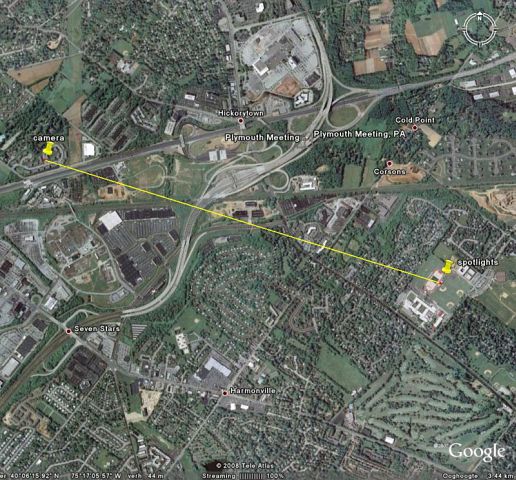
Continuing east-southeast along this yellow line, we reach the athletics field of the Plymouth Whitemarsh High School. The field is bordered by four big spotlights, two of which are directed exactly towards the spot from where the photo was taken. Hence, presumably, not one, but two reflections.
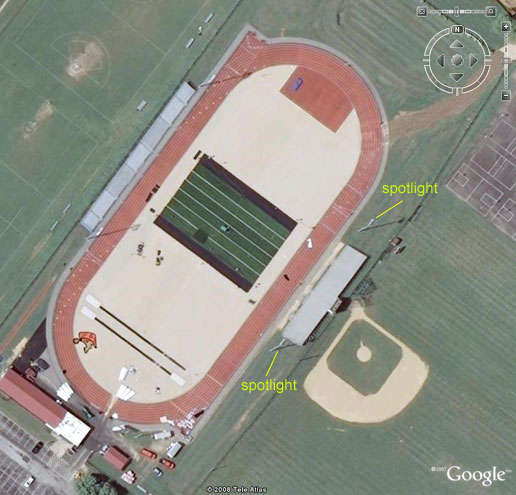
The distance between David's location and the spotlights is 1.84 miles (2.96 km). This implicates that, in order to produce a reflection midway the camera and the light source under an angle of 15°, the ice-crystal layer should have been (1,84/2 x tan 15° =) 0.2465 miles or 1,301 feet (397 m) above the ground. This is too high for a cloud of ice crystals to be classified as ice mist and too low for an ice cloud to be considered a member of the cirrus family. Consequently, we are dealing with "light pillars in low cloud" (see our picture gallery for examples of different light pillar categories). Because the reflecting cloud layer is close to the ground, even less powerful lights are mirrored in the sky. Unlike light pillars seen in ice mist, the pillars do not interconnect with their light sources and appear to be suspended in mid air, making it difficult for an observer to identify the light sources that cause the sky pillars. Although these displays are not so rare in colder regions, such as Alaska and Finland, they very seldom occur at lower latitudes.
Our explanation for the Philadelphia lights is backed up by the following brief description, posted on the NBC Philadelphia Weather Stories forum by Mr. Guy McGUYERSON who saw the pillars while walking his dog:
"At one point during my walk I was standing right underneath one. Looking straight up I thought you could see what looked like little white crystals making up the glow" [2].
Although Mr. McGUYERSON had no idea as to what it was that caused the ice-crystal plates to light up, it is clear that there must have been a light source pointing skyward very close to where he was standing. A good candidate would be a spotlight illuminating a building or an advertising sign from beneath and mounted a few metres above the ground so that someone standing close to it could easily miss it. It should also be taken into account that celestial objects seen at elevations of 80° are often considered by witnesses to be "straight above them". Supposing that the pillar seen close up by Mr. McGUYERSON was 10° off of the zenith and the reflecting layer was 1,301 feet (397 m) above the ground, the light source would have been 459 feet (140 m) away from him. In those circumstances, buildings or trees could easily have blocked the light source from view.
The "mysterious lights" that appeared over Philadelphia in the evening of November 19, 2008, were an optical atmospheric phenomenon which we designated as "light pillars in low cloud".
Images like the ones taken by David WEI provide a unique opportunity to assess the degree of light pollution caused by a big city.
For a lengthy paper on light pillars in high clouds (the mechanism of which is identical to light pillars observed in low clouds), we refer to the six part article on our research page.
Our thanks to photographer David WEI, eye-witnesses Daniel LEVIN and Anthony VELGUS, and veteran UFO researcher Matthew GRAEBER for assisting us with this investigation and making our work known to a wider audience.
[1] Personal correspondence with David WEI in the course of November-December 2008.
[2] E-mail of November 20, 2008, posted by Guy McGuyerson on the NBC Philadelphia Weather Stories forum.





